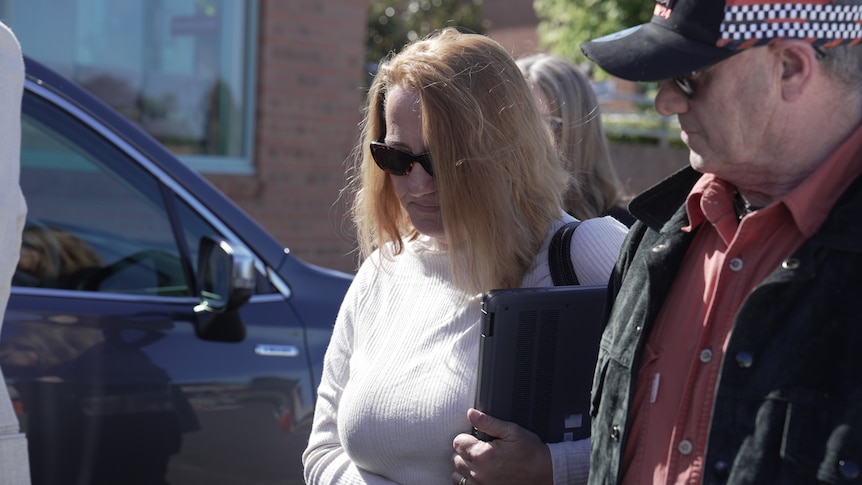Australia Weather News

Rosemary Gamble is the operator of the jumping castle involved in the deaths of six Tasmanian children in 2021. (ABC News: Bec Pridham)
The Chinese manufacturer of the jumping castle at the centre of the Hillcrest Primary School tragedy preyed on its customers, a court has been told.
On Monday, the Devonport Magistrates Court heard closing submissions from lawyers in the case against Rosemary Anne Gamble, who is charged with failing in her work health and safety duty in a way that resulted in the deaths of six children.
Zane Mellor, Peter Dodt, Jalailah Jayne-Maree Jones, Addison Stewart, Jye Sheehan, and Chace Harrison died and three of their classmates were seriously injured when a freak wind event referred to as a "mini tornado" tossed a jumping castle across the Devonport school oval on December 16, 2021.
Ms Gamble, trading as Taz-Zorb, was the operator of the jumping castle and pleaded not guilty to the charge ahead of a two-week hearing in the court in November.
The Crown alleged Ms Gamble failed in several ways including to ensure the jumping castle was properly anchored to the ground, given that only four pegs had been used despite the castle having eight anchor points.
The defence targets manufacturer
At the beginning of opening statements on November 5, defence lawyer Chris Dockray SC appeared to place some of the blame at the feet of East Inflatables, the Chinese company that manufactured the jumping castle.
In closing statements before Magistrate Robert Webster, Mr Dockray returned to that argument.
He said it was East Inflatables' business model to "prey upon people like Ms Gamble" to sell jumping castles.
However, Crown prosecutor Madeleine Wilson SC said Ms Gamble had concerns during the purchase period and made "no further enquiries".
The court previously heard evidence that Ms Gamble had sought assurances from the company that their products complied with Australian standards when she bought it in 2015.
In emails shown to the court, staff of the company provided such assurances and further stated the castle would also comply with European standards.
"Hence, don't worry about our product quality," the email said.
Mr Dockray said his client also sought to ensure she was properly informed about how to operate the jumping castle because she downloaded a two-page manual from the company's website.
He said the company relied on a "suite of lies and deception" to finalise sales, including inventing competing buyers, and that they encouraged buyers to avoid paying taxes.
These factors amounted to an "appalling indictment" of the company, Mr Dockray said.
"I would urge your honour to find very adverse findings against East Inflatables," he said.
However, Crown prosecutor Madeleine Wilson SC said these interactions showed the company would correspond with its customers and that if Ms Gamble had concerns, she should have raised them with the company.
"If she had all those reservations suggested … it would have been highly unreasonable for her to rely on any overture from them to ensure their castle was compliant with Australian standards," Ms Wilson said.
Expert witnesses disagree
During the hearing two key mechanical engineering experts disagreed fundamentally on whether the tragedy could have been prevented, and Mr Dockray focused on how Mr Webster should resolve those disagreements.
Crown witness Roderick McDonald said if Ms Gamble was unsure about how to safely operate the castle, she should have sought help from an expert.
But expert Professor David Eager, from the University of Technology Sydney, said nothing Ms Gamble could have done would have prevented the tragedy that unfolded.
Mr Dockray relied on this, and the fact that wind events like the mini tornado — also known as a dust devil — that caused this tragedy could not be forecast, to make a general submission.
"No one could have foreseen the dust devil, and no anchorage system would have prevented the outcome," he said.
He told Mr Webster that where two experts disagreed, the court could only make findings against his client or in favour of the Crown if they were proven beyond reasonable doubt.
Ms Wilson referred to the experts' disagreements but repeated Mr McDonald's assertion the use of eight anchor points could have prevented the tragedy.
"Mr McDonald says the design of the anchorage system is absolutely critical in preventing lift," she said.
During the hearing, Mr McDonald said if eight star pickets — which were available on the day — were used to anchor the castle, it would not have left the ground.
Decision months away
Although families of the victims may have been hoping for a quick resolution to the case now the closing submissions had been made, Magistrate Robert Webster hosed that down.
He said neither he nor a courtroom in Devonport was available for several months, though he was aware the date of the decision was what "most people want to know".
He adjourned the case to deliver his decision on June 6.
ABC